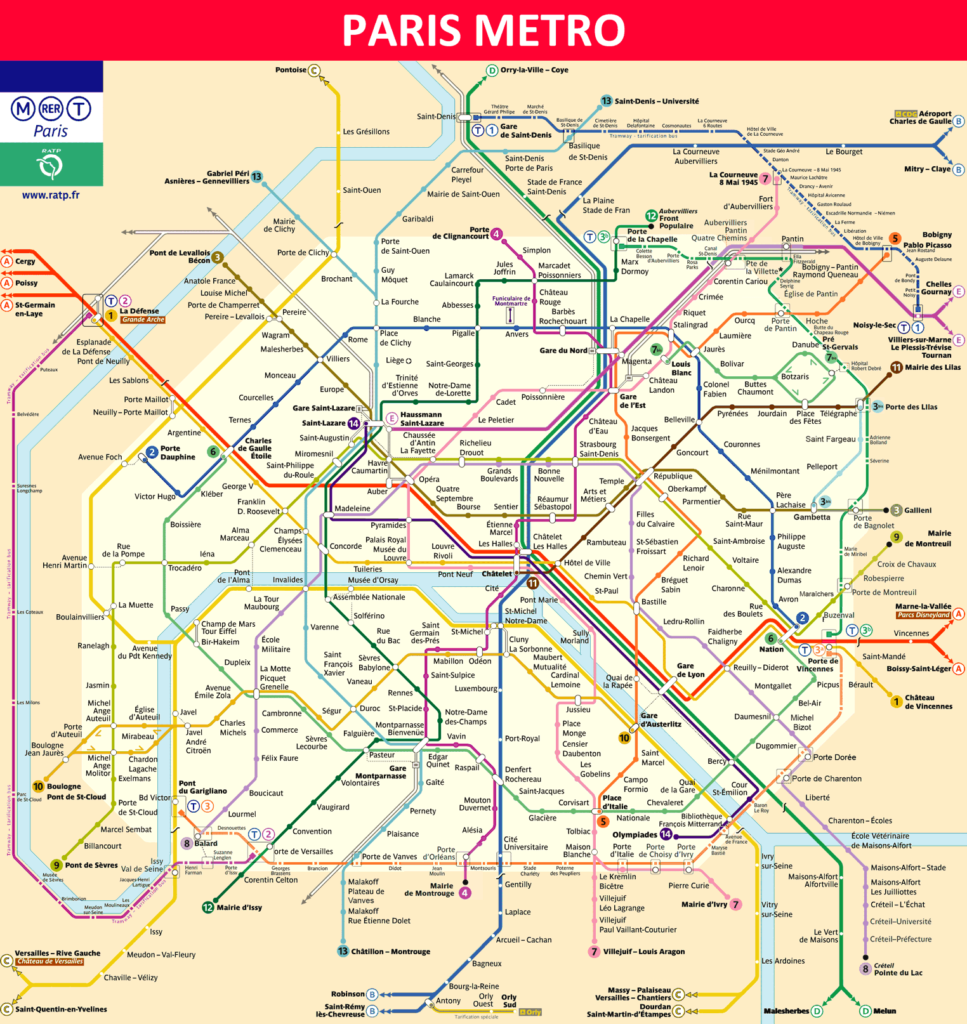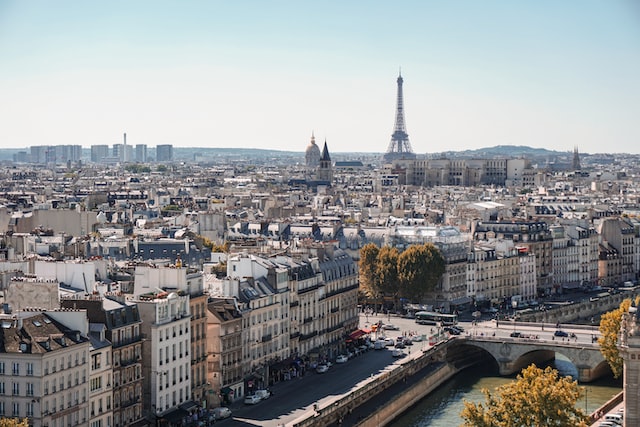Paris’ large and dependable public transportation system makes getting around the city simple. The enormous metro system in Paris, which has more than 300 stations and 16 lines, is the primary mode of public transportation. Paris also has buses, trams, RER trains, Noctilien night buses, and the Orlyval light rail line as other modes of public transportation. Autolib, a bike-sharing scheme in Paris, also allows customers to rent electric vehicles, scooters, and bicycles. The Navigo pass, a contactless smart card that provides access to all public transportation in Paris and its suburbs, includes all of these modes of transportation.
Basic information about the Metro system in Paris
The Paris metro system is one of the biggest in the world, with more than 300 stations dispersed among 16 lines. It’s an efficient and affordable method to get around the city, and both single tickets and unlimited travel cards are easily accessible. Every day from 5:30 a.m. to 1:30 a.m., the metro runs, with certain lines operating 24 hours a day. It is dependable and speedy. Most stations have well-marked, user-friendly elevators and escalators. Because it is convenient and cheap, the Paris Metro is an important part of the city’s public transportation system.
The lines of the Paris subway system
The Paris Metro is one of the busiest, best, and most reliable subway systems in the world. It has more than 300 stations and 16 lines. It is also one of the most recognizable. The RER (Regional Express Network), the Transilien, the Métro, and the Tramway are the four divisions of the Paris Metro lines (T2, T3 & T4). A regional express network called the RER links the suburbs with the capital of Paris. It consists of five lines that serve the city’s center and the neighboring areas: A, B, C, D, and E. The RER is the quickest means of transportation within the city and its environs. A system of regional trains known as the Transilien links the city of Paris with its suburbs and with other cities in the area. Eight lines make up this poem: H, J, K, L, N, P, R, and U.
The most well-known Paris Metro line is the Métro, or underground. It has 303 stations and sixteen lines, including 1, 2, 3, 3bis, 4, 5, 6, 7, 7bis, 8, 9, 10, 11, 12, 13, and 14. On the maps, the lines are clearly marked and color-coded. Last but not least, the Tramway has three lines: T2, T3, and T4. The suburbs and the city center are connected by these lines.
Getting about the city and its suburbs is simple thanks to the Paris Metro line’s dependability and efficiency. The Paris Metro lines are a terrific way to get around whether you are a local or a visitor to the city.
Map of Paris Metro 2023 – Free Download in PDF

Anyone planning to travel to the City of Lights must have the Paris Metro pass for 2023. This detailed PDF, which you can download for free, has information about the different lines, stations, and places of interest. This map makes it easy to plan your route and get where you want to go quickly and easily. The map is a fantastic method to learn more about the city, as it has comprehensive information on the neighborhood, points of interest, and more. Get your free copy of the Map of Paris Metro 2023 now so you don’t miss out!
Public transport tickets in Paris – Best types for travelers & actual prices
For first-time visitors to Paris, the city might be intimidating, but with the correct preparation, the trip can be delightful and stress-free. Tickets for public transportation, which are necessary for moving around the city, are among the most crucial factors. You may learn about the different ticket options, costs, and helpful hints in this post.
There are various different kinds of tickets available in Paris. Single-use tickets, which are available for all modes of public transportation, including the metro, RER, trams, buses, and funiculars, are the most extensively used and are only good for one trip. Both ticket offices and station ticket machines sell these tickets for the price of €1.90 each.
The Paris Visite travel card is a fantastic choice for guests who intend to frequently commute by public transportation while they are there. This pass is available in different ways, such as for one day, five days, or for a longer period of time. For the term of the pass, unlimited use of the metro, RER, trams, buses, and funiculars is permitted. A 1-day pass costs €12.50, and a 5-day pass costs €36.50.
Children under the age of four ride the bus or train for free, and kids between the ages of 4 and 11 can buy a ticket for €1.90. Additionally, there are special reductions available for children, the elderly, and those with impairments.
Prior to boarding a public transportation vehicle, it’s crucial to confirm your ticket. Tickets must be checked at the ticket machines before getting on the metro, RER, trams, or buses. By doing so, the tickets are guaranteed to be valid and the transportation authority is able to keep track of the number of passengers. Finally, be aware that you might need to use a particular type of ticket at some stations or lines. Usually, both the station signs and the ticket machines make this clear.
We really hope that this post was beneficial in educating you about the different kinds of public transportation tickets offered in Paris, as well as their costs and helpful hints. With this knowledge, you will be well-equipped to enjoy your time in Paris to the fullest.
Summary of fares for public transport in Paris
- Single-use tickets ($1.90 each) and the Paris Visite travel card ($12.50 for a one-day pass and $36.50 for a five-day pass).
- Children under 4 ride free, and ages 4 to 11 ride for €1.90.
- Prior to boarding, check your ticket; some stations/lines require a certain type of ticket.
Timetables & Schedules of the Paris Metro system
Monday through Thursday, the Paris Metro runs from 5:30 a.m. to 12:30 a.m.; Friday from 5:30 a.m. to 1:30 a.m.; Saturday from 7:30 a.m. to 1:30 a.m.; and Sunday from 9:00 a.m. The morning rush hour (from 7:30 am to 9:30 am) and the evening rush hour are often the busiest times on the Metro (4:30 pm to 6:30 pm). The Metro operates longer hours in the summer, from 5:30 a.m. to 1:30 a.m. on weekdays and 9:00 a.m. to 12:30 a.m. on weekends.
What Are Other Options for Public Transportation in Paris?
Although you are certainly already familiar with the metro if you are in Paris, there are actually a number of additional choices for public transportation in the city. Even though the metro might be the most convenient option, these other options can give you a unique experience and are often faster. Here are some additional Parisian public transit choices to consider:
Parisian Buses
Using the bus to go around Paris is a terrific idea. Most areas of the city are covered by several routes. The bus is another affordable option, and tickets may be bought in a variety of places. The buses are a greener alternative, and on many lines, you may even ride in air conditioning. Staying connected is simple on some buses because they include Wi-Fi and USB connections.
RER – Réseau Express Régional
There are many commuter train stations across Paris served by the Réseau Express Régional (RER). It’s an excellent alternative for traveling to and from Paris because it includes a number of lines that connect the city’s core with the outskirts. The RER also provides access to many of the attractions around Paris, like the Eiffel Tower and Notre-Dame Cathedral. Additionally, some of the lines run through Paris’ most famous neighborhoods, including Montmartre and the Latin Quarter. When using the RER, passengers can expect to get to their destination quickly and reliably.
Light rail system – Tramway
A light rail system called the tramway provides service to various areas of the city. It’s a fantastic choice for anyone who wants to go around the city fast and avoid the congested subway. The tramway covers main areas such as the city center, the old town, the university, and some residential areas. It is also connected to the subway network in some areas, making it easy to switch between the two.
Riverboats along the Seine
Using a riverboat to navigate the city and take in the sights is a terrific idea. You can board and depart the boats at several locations along the Seine by purchasing tickets for a single ride or a day pass. Riverboats offer a unique way to get around the city and explore. There are three types of boats. Traditional riverboats are the most common and have a classic design with open decks and canopies. Smaller boats that can move on their own are a great way to explore the city’s canals, while dinner and sightseeing boats with covered decks offer a more luxurious experience. No matter which type of boat you choose, you can expect a comfortable and beautiful ride. The boats offer plenty of seating, and the views of the river are spectacular. Along the way, you may pass famous landmarks such as the Eiffel Tower and Notre Dame Cathedral. You can also take in the views of the historic bridges, monuments, and parks as you glide along the river.
Noctilien – Night buses
Noctilien is a night bus service that runs throughout the suburbs of Paris. After the metro stops operating, it’s a fantastic alternative for traveling around. Noctilien buses leave from different spots in the city and run until the early morning. There are a variety of lines available, including those that travel to and from major train stations, airports, and tourist attractions. Passengers can purchase tickets on board the bus or in advance from an automated ticket machine. For those who need to travel farther, there are also direct lines that run between the suburbs of Paris and other cities in the region. With Noctilien, traveling around the city at night has never been easier.
These are only a few of Paris’s available public transportation choices. There are several methods to get around the city, whether you want to take the bus to see the sights, cruise the river to take in the vistas or ride the Noctilien at night.
How to Take Public Transportation From Paris Charles de Gaulle Airport (CDG) to the City Center
For those who are unfamiliar with the area, getting from Paris Charles de Gaulle airport to the city center might be a challenging endeavor. However, using public transit to get to the city center only requires a few easy steps.
Finding the RER station at the airport is the first step. You can find this by locating the “RER” or “Train” signs. You must buy a ticket once you arrive at the station. You can buy tickets at the ticket office or from the ticket machines. You must buy a ticket for Zone 1 in order to travel to the city centre.
You can ride the RER B train towards the city centre after buying a ticket. Along the trip, the train will stop at a number of stops, including Saint-Michel-Notre-Dame, Châtelet-Les Halles, and Gare du Nord. You can decide whether to get off at any particular station along the way or ride the train all the way to its destination.
The most convenient way is Bolt!
Bolt (European UBER) is a convenient way to get from Ruzyne Airport to the city center. The journey takes around 25 minutes depending on traffic, and the cost is approximately 600 Kč. It’s recommended to book a taxi in advance to avoid the queues, or you can pick one up at the taxi stand at the airport.
Overall, using public transit to go from Paris Charles de Gaulle airport to the city centre is a relatively simple process. You can easily reach your destination if you take the above-mentioned measures.
What kind of sightseeing do you have to see if you visit Paris for THE first time?
Paris is one of the most well-known cities in the world when it comes to renowned cities. Paris is a city full of intriguing attractions and activities, from its beautiful architecture to its vibrant culture. So, if you want to see this amazing city, these are the top Paris attractions you should see.
The Eiffel Tower is first. One of the most famous landmarks in the world, this one provides breathtaking views of the city. Couples will like it because it is also home to some of Paris’ most romantic locations.
Visit the Louvre Museum next. This magnificent museum, one of the biggest in the world, is home to some of the best-known pieces of artwork. It’s a terrific spot to explore Paris’s art and culture, from the Mona Lisa to the Venus de Milo.
Visit the Paris Catacombs if you’re searching for something a little further off the main path. This underground graveyard is a terrific place to see the city’s darker side and is full of ancient bones.
Last but not least, saunter through the Champs-Élysées. This well-known street is surrounded by stores, eateries, and cafes, making it the ideal place to view some of the city’s most well-known landmarks.
Whatever your hobbies, there is something in Paris for you. It’s a city that will leave you with enduring memories, from well-known landmarks to little-known gems. For a truly unique experience, be sure to explore these top attractions when you are in the city.
Summary of our tour guide for Paris
Paris is a stunning city brimming with culture and life. It’s not surprising that this city is among the most visited in the world with its recognizable landmarks, renowned museums, and stunning architecture. The vast network of metro lines, buses, trams, and regional rail services in Paris makes it easy and comfortable to get around the whole city. It’s easy to go around and experience the city thanks to low costs and regular service.
Top 5 FAQs and answers about Paris public transport?
- What modes of transportation are offered in Paris?
- Buses, trams, the Metro, RER trains, boat shuttles, and the Velib bike share programme are all part of the Paris public transportation system. The most well-liked and practical methods of moving around the city are the bus, RER, and Metro networks. In addition to the five RER lines that connect Paris to its suburbs, the Metro system in Paris has 16 lines.
- How much does using the Parisian public transportation system cost?
- Depending on the mode of transportation utilised, the price of a single trip on the Paris public transportation system varies. A single ride on the boat shuttles or the Velib bike sharing costs €2, whereas a single ride on the Metro, RER, or bus costs €1.90.
- From where can I purchase tickets for the Parisian subway system?
- At every bus stop and Metro station in Paris, ticket machines sell tickets for the city’s public transportation system. The ticket offices at significant Metro and RER stations also sell tickets.
- What does “Navigo pass” mean?
- An electronic pass called the Navigo pass can be used to pay for transportation on the Parisian public transportation system. It can be used on all forms of city transportation and is offered in weekly, monthly, and annual choices.
- Is the public transportation in Paris secure?
- Although the public transportation in Paris is generally secure and safe, it is advised that you exercise the same common sense care as you would in any major city. It’s also critical to be cautious of pickpockets and secure your belongings.
.Useful links








1 thought on “Paris Metro”